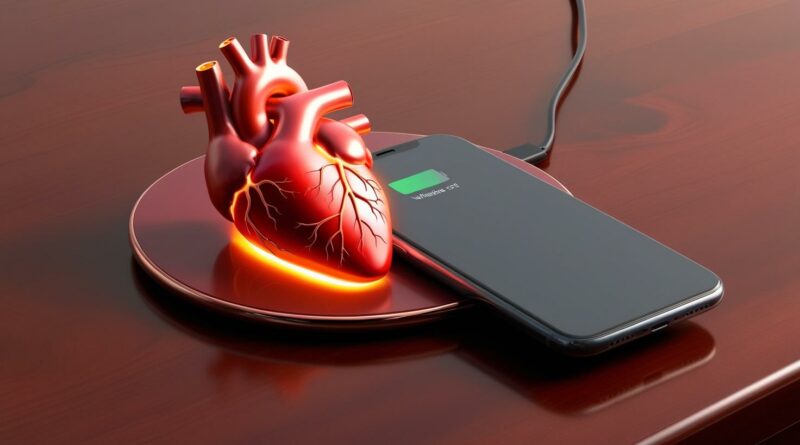How Your Body Movements Could Soon Charge Your Devices
With our absolute depence on portable electronic devices, the tedious ritual of charging batteries could soon become obsolete. Researchers at the Daegu Gyeongbuk Institute of Science and Technology (DGIST) in South Korea have developed a revolutionary energy-harvesting device that converts ordinary body movements into electricity—with an efficiency 280 times greater than existing technologies.
The Power Within Us
Every step you take, every move you make—your body is constantly in motion, generating kinetic energy that typically dissipates unused into the environment. The concept of harvesting this energy isn’t new, but previous attempts have faced significant challenges in creating devices that are both powerful and comfortable enough for practical use.
“The human body is essentially a walking power station,” explains Dr. Jane Morgan, an independent expert in wearable technology not involved in the research. “The challenge has always been efficiently capturing that energy without impeding movement or comfort.”
A Piezoelectric Breakthrough
The DGIST innovation utilises the piezoelectric effect, a phenomenon where certain materials generate an electric charge when subjected to mechanical stress. While piezoelectric energy harvesting has existed for decades, the South Korean team’s approach represents a quantum leap forward in efficiency.
At the heart of this advancement is a novel three-dimensional structure that incorporates lead zirconate titanate (PZT)—a material known for its exceptional piezoelectric properties but traditionally too rigid for wearable applications. The researchers overcame this limitation through clever engineering that maintains the material’s power generation capabilities while providing the flexibility necessary for comfort when worn against the skin.
“What makes this particularly exciting is the combination of high efficiency with wearability,” says Professor Hwan-Jin Choi, lead researcher at DGIST. “Previous devices often sacrificed one for the other. Our design achieves both.”
Capturing Every Microwatt
Perhaps the most significant innovation in the DGIST device is its “curvature-specific coupling electrode,” designed to capture the electrical energy generated by the piezoelectric material with unprecedented efficiency.
In conventional designs, a substantial portion of generated energy is lost during the harvesting process. The newly engineered electrode ensures nearly all energy produced is effectively captured and converted to usable electricity—accounting for the remarkable 280-fold improvement in efficiency compared to existing stretchable piezoelectric harvesters.
The implications for wearable technology are profound. Smartwatches, fitness trackers, and medical monitoring devices could potentially operate indefinitely without external power sources, drawing all needed energy from the wearer’s normal daily movements.
From Laboratory to Lifestyle
While the technology shows tremendous promise, consumers shouldn’t expect to see it in commercial products immediately. The research team is currently working to refine the technology for mass production and exploring potential applications across multiple industries.
“We’re looking at scaling the technology for different wearable formats,” Professor Choi notes. “The applications extend beyond consumer electronics to medical implants, environmental monitoring systems, and even smart textiles.”
Dr. Morgan suggests the impact could be particularly significant for medical devices: “Consider implantable health monitors or drug delivery systems that could operate perpetually without battery replacement surgery. The quality-of-life improvements could be enormous.”
A Sustainable Energy Solution
Beyond convenience, body-powered devices offer compelling environmental benefits. The billions of batteries used in wearable devices annually represent a significant source of waste and resource consumption. Self-powered electronics could dramatically reduce this environmental footprint.
The technology also aligns with the growing Internet of Things ecosystem, where billions of connected devices require power sources. Body movement-generated electricity could help overcome one of the most significant barriers to widespread IoT adoption.
The Road Ahead
Published in the prestigious journal ACS Nano, the DGIST research represents a significant milestone but not the end of the journey. The team continues to improve the technology’s durability, efficiency, and manufacturability.
“We’re particularly focused on improving performance under real-world conditions,” says Professor Choi. “Laboratory demonstrations are promising, but wearable technology must withstand the rigours of daily life.”
Industry observers anticipate commercial applications could begin appearing within 2-3 years, likely beginning with specialised applications before expanding to mainstream consumer devices.
The Future is Self-Powered
As wearable health monitoring becomes increasingly important in preventative healthcare, the ability to power these devices continuously through body movement could enable 24/7 health tracking without user intervention.
Similarly, the technology could transform augmented reality devices, hearing aids, and other assistive technologies by eliminating battery anxiety and reducing device size and weight.
“What the DGIST team has accomplished is remarkable,” concludes Dr. Morgan. “This isn’t incremental improvement—it’s the kind of step-change innovation that could fundamentally alter how we think about powering personal electronics.”
In a world increasingly concerned with sustainability and convenience, the prospect of tapping into the energy we naturally generate through movement represents an elegant solution to multiple challenges. Your next smartwatch might not just track your steps—it might be powered by them.
We’d love your questions or comments on today’s topic!
For more articles like this one, click here.
Thought for the day:
“We can improve our relationships with others by leaps and bounds if we become encouragers instead of critics.” Joyce Meyer



